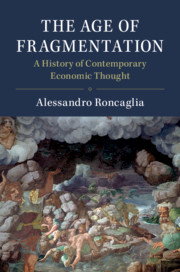Book contents
- The Age of Fragmentation
- The Age of Fragmentation
- Copyright page
- Contents
- Acknowledgements
- 1 Introduction: A Non-linear Discourse
- Part I The Background
- Part II The Giants of the Short Century
- Part III The Disgregation of the Mainstream
- 6 The New Microeconomics: General Equilibrium and Expected Utilities, Theory of Industrial Organization
- 7 The Macroeconomics of the Neoclassical Synthesis
- 8 The Myth of the Invisible Hand: Neo-liberal Streams
- 9 Applied Economics and Econometrics
- Part IV The Weakening of the Paradigm
- Part V Is a New Paradigm Possible?
- References
- Index
6 - The New Microeconomics: General Equilibrium and Expected Utilities, Theory of Industrial Organization
from Part III - The Disgregation of the Mainstream
Published online by Cambridge University Press: 25 November 2019
- The Age of Fragmentation
- The Age of Fragmentation
- Copyright page
- Contents
- Acknowledgements
- 1 Introduction: A Non-linear Discourse
- Part I The Background
- Part II The Giants of the Short Century
- Part III The Disgregation of the Mainstream
- 6 The New Microeconomics: General Equilibrium and Expected Utilities, Theory of Industrial Organization
- 7 The Macroeconomics of the Neoclassical Synthesis
- 8 The Myth of the Invisible Hand: Neo-liberal Streams
- 9 Applied Economics and Econometrics
- Part IV The Weakening of the Paradigm
- Part V Is a New Paradigm Possible?
- References
- Index
Summary
In the framework of a critical illustration of the contemporary history of economics, this chapter provides an assessment of the development of microeconomics since von Neumann’s and Morgenstern’s theory of expected utility, including the developments of general equilibrium theory, reproposals by the Chicago school and others of the Marshallian theory, Samuelson’s Marshallian-Walrasian synthesis, the new theories of the irm (oligopoly and barriers to entry, contestable markets and others), growth and limits of game theory.
Keywords
- Type
- Chapter
- Information
- The Age of FragmentationA History of Contemporary Economic Thought, pp. 113 - 145Publisher: Cambridge University PressPrint publication year: 2019

